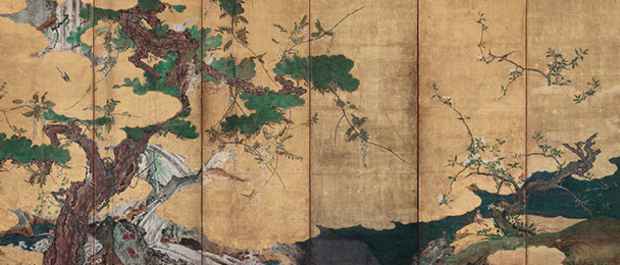“A Giant Leap: The Transformation of Hasegawa Tōhaku” Exhibition
Japan Society Gallery

This event has ended.
Japan Society Gallery presents A Giant Leap: The Transformation of Hasegawa Tōhaku, the first U.S. exhibition focused on the works and stylistic transformation of Hasegawa Tōhaku (1539—1610). A large, jagged pine tree, its branches wound with wisteria and its trunk edged with red azalea, a waterfall cascading into a deep blue stream, and dandelions and violets sprouting before a crab-apple tree; Hasegawa Tōhaku’s Flowers and Birds of Spring and Summer screen is one of the most important works on view in A Giant Leap and one of the most important in the study of Tōhaku at large, forming the “missing link” in the painter’s career.
Widely recognized as one of Japan’s most beloved painters and artistic innovators, this exhibition marks a rare showing of his remarkable painted screens and scrolls in the U.S., including four Important Cultural Properties on loan from Japanese collections. A Giant Leap especially highlights research that reveals his paintings, formerly attributed to two separate painters (“Nobuharu” and “Tōhaku”), to be the work of a single person. The exhibition displays works marked under each name. A Giant Leap also features new video interviews with leading Tōhaku scholars, including Buddhist temple abbots and exhibition co- supervisor Professor Miyeko Murase (Professor Emerita, Columbia University and former special consultant for Japanese Art at The Metropolitan Museum of Art). To experience Tōhaku’s works as though they were in a Buddhist temple, visitors to Japan Society Gallery have the opportunity to sit barefooted and on the floor in close proximity to an uncased, high-quality facsimile of Tōhaku’s famous painted pine trees screen.
This spring, a variety of programming invites visitors to experience and understand the works of Tōhaku unlike ever before with weekly meditation, workshops, talks and events. Every Tuesday through the duration of the exhibition, visitors can practice the art of meditation inside the North Gallery with 45-minute sessions led by masters from New York Zendo Shobo-ji in Midtown Manhattan. Other related events include: a group art-making workshop by Brooklyn-based artist Tomokazu Matsuyama, who will also reflect on the influence of Tōhaku on his own art; a talk identifying bird and flower species found in Tōhaku’s paintings led by Japanese garden curator Brian Funk (Brooklyn Botanical Garden) and ornithologist Paul Sweet (American Museum of Natural History); and an illustrated lecture that uncovers Tōhaku’s dramatic artistic style transformation, by exhibition co- supervisor Professor Miyeko Murase.

A Giant Leap conveys the dramatic transformation of a painter from the provinces into one of Japan’s most important and beloved artists of the sixteenth-century. Owing to their rarity and in order to preserve their remarkable condition, the screens and scroll paintings will be displayed in two rotations, March 9—April 8, 2018 and April 12—May 6, 2018.
In 1964, art historian Tsugiyoshi Doi first proposed a theory that Hasegawa Tōhaku signed and sealed his work with a different name—Hasegawa Nobuharu—during his youth. The vast stylistic discrepancy between works bearing the name “Nobuharu” and those marked “Tōhaku” raised questions among scholars. For decades, no single painting could be identified as bridging the gap separating these oeuvres. Representing the left-hand screen of a pair (the whereabouts of its counterpart are unknown), Birds and Flowers of Spring and Summer is today considered the proverbial “missing link,” with tell-tale stylistic details revealing its unique position within the painter’s career.
Tōhaku has been the subject of renewed attention in recent years, including at the Kyoto National Museum and the Tokyo National Museum, where the 400th anniversary of the artist’s death was commemorated in an important 2010 survey exhibition. Raised in a family of cloth-dyers in Nanao, on the Sea of Japan coast in the Hokuriku region of Japan’s main island, Tōhaku began his career as a provincial painter of Buddhist paintings, working under the name “Nobuharu”. He later moved to Kyoto, the heart of late 16th-century Japanese politics and culture, where he studied Chinese and Japanese painting and accepted instruction from Kanō Shōei, head of the Kanō school, which supplied paintings to Japan’s leading samurai. In the 1580s, he appears to have begun using the name “Tōhaku,” a switch in nomenclature that coincided with a shift in his style. While producing painted screens covered in vast expanses of gold leaf, Tōhaku also began to demonstrate a mastery of sumi-e (ink painting) at this stage in his career. By 1590, he had emerged as the leading painter of his day, founding his own school of painting—the Hasegawa school—consisting primarily of his own sons. Tōhaku became the favored painter for Sen no Rykyu and the powerful daimyō Toyotomi Hideyoshi and, at the turn of the 17th-century, he was summoned to the new capital of Edo by Hideyoshi’s successor, Tokugawa Ieyasu (founder of Tokugawa shogunate), where he remained briefly until his death.
“Weare thrilled to stage this momentous exhibition of rare works by Hasegawa Tōhaku. In many ways, the exhibition exemplifies Japan Society’s unique capability to provide a window onto Eastern scholarship, acquiring Important Cultural Properties from Japan and presenting them in a single exhibition in the U.S. As many of the loans are previously unseen in the West, A Giant Leap is an opportunity for Tōhaku’s genius to be recognized at an international level that has not yet been achieved in the U.S.,” said Yukie Kamiya, director of Japan Society Gallery.
The exhibition is conceived and supervised by Dr. Miyeko Murase (Professor Emerita, Art History and Archaeology Department, Columbia University and former special consultant for Japanese Art, Asia Department, The Metropolitan Museum of Art) with Dr. Masatomo Kawai (professor emeritus, Keio University and director, Chiba City Museum of Art) in consultation with Yukie Kamiya, director of Japan Society Gallery.
Media
Schedule
from March 09, 2018 to May 06, 2018